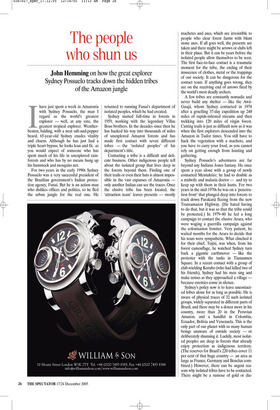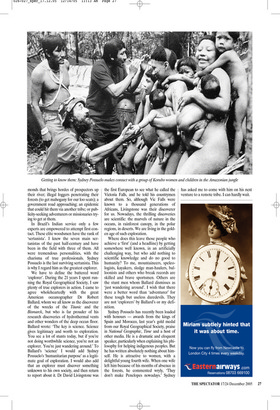The people who shun us
John Hemming on how the great explorer Sydney Possuelo tracks down the hidden tribes of the Amazon jungle Ihave just spent a week in Amazonia with Sydney Possuelo, the man I regard as the world’s greatest explorer — well, at any rate, the greatest tropical explorer. Weatherbeaten, balding, with a neat salt-and-pepper beard, 65-year-old Sydney exudes vitality and charm. Although he has just had a triple heart bypass, he looks lean and fit, as you would expect of someone who has spent much of his life in unexplored rainforests and who has by no means hung up his hammock and mosquito net.
For two years in the early 1990s Sydney Possuelo was a very successful president of the Brazilian government’s Indian protection agency, Funai. But he is an action man who dislikes offices and politics, so he fled the urban jungle for the real one. He returned to running Funai’s department of isolated peoples, which he had created.
Sydney started full-time in forests in 1959, working with the legendary Villas Boas brothers. In the decades since then he has hacked his way into thousands of miles of unexplored Amazon forests and has made first contact with seven different tribes — the ‘isolated peoples’ of his department’s title.
Contacting a tribe is a difficult and delicate business. Other indigenous people tell about the isolated group that lives deep in the forests beyond them. Finding one of their trails or even their huts is almost impossible in the vast expanses of Amazonia only another Indian can see the traces. Once the elusive tribe has been located, the ‘attraction team’ leaves presents — mostly machetes and axes, which are irresistible to people who clear forest farms with blunt stone axes. If all goes well, the presents are taken and there might be arrows or clubs left in their place. But it can be years before the isolated people allow themselves to be seen. The first face-to-face contact is a traumatic moment for the tribe, the ending of their innocence of clothes, metal or the trappings of our society. It can be dangerous for the contact team. If anything goes wrong, they are on the receiving end of arrows fired by the world’s most deadly archers.
A few tribes are constantly nomadic and never build any shelter — like the AwáGuajá, whom Sydney contacted in 1978 after a gruelling 37-day expedition up 240 miles of rapids-infested streams and then trekking into 120 miles of virgin forest. Cutting trails is just as difficult now as it was when the first explorers descended into the Amazon in Tudor times. You still have to hack the vegetation with a machete, and you have to carry your food, as you cannot rely on getting enough from hunting and gathering.
Sydney Possuelo’s adventures are far beyond any Indiana Jones fantasy. He once spent a year alone with a group of newly contacted Mentuktire; he had to double as a midwife and malaria doctor — and try to keep up with them in their hunts. For two years in the mid-1970s he was on a ‘penetration front’ that plunged deep into forests to track down Parakanã fleeing from the new Transamazon Highway. (He hated having to do that, but it was so that the tribe could be protected.) In 1979–80 he led a long campaign to contact the elusive Arara, who were waging a guerrilla campaign against the colonisation frontier. Very patient, he waited months for the Arara to decide that his team were sympathetic. What clinched it for their chief, Tojtxi, was when, from his forest camouflage, he watched Sydney turn back a gigantic earthmover — like the protester with the tanks in Tiananmen Square. In a recent contact with a group of club-wielding Korubo (who had killed two of his friends), Sydney had his men sing and make noises as they approached a village because enemies come in silence.
Sydney’s policy now is to leave uncontacted tribes alone for as long as possible. He is aware of physical traces of 32 such isolated groups, widely separated in different parts of Brazil, and there may be a dozen more in his country, more than 20 in the Peruvian Amazon, and a handful in Colombia, Ecuador, Bolivia and Venezuela. This is the only part of our planet with so many human beings unaware of outside society — or deliberately shunning it. Luckily, most isolated peoples are deep in forests that already enjoy protection as indigenous territory. (The reserves for Brazil’s 220 tribes cover 11 per cent of that huge country — an area as large as France, Germany and Benelux combined.) However, there can be urgent reasons why isolated tribes have to be contacted. There might be a rumour of gold or dia monds that brings hordes of prospectors up their river; illegal loggers penetrating their forests (to get mahogany for our loo seats); a government road approaching; an epidemic that could hit them via another tribe; or publicity-seeking adventurers or missionaries trying to get at them.
In Brazil’s Indian service only a few experts are empowered to attempt first contact. These elite woodsmen have the rank of ‘sertanista’. I knew the seven main sertanistas of the past half-century and have been in the field with three of them. All were tremendous personalities, with the charisma of true professionals. Sydney Possuelo is the last surviving sertanista. This is why I regard him as the greatest explorer.
We have to define the battered word ‘explorer’. During the 21 years I spent running the Royal Geographical Society, I saw plenty of true explorers in action. I came to agree wholeheartedly with the great American oceanographer Dr Robert Ballard, whom we all know as the discoverer of the wrecks of the Titanic and the Bismarck, but who is far prouder of his research discoveries of hydrothermal vents and other wonders of the deep ocean floor. Ballard wrote: ‘The key is science. Science gives legitimacy and worth to exploration. You see a lot of stunts today, but if you’re not doing worthwhile science, you’re not an explorer. You’re just wandering around.’ To Ballard’s ‘science’ I would add Sydney Possuelo’s ‘humanitarian purpose’ as a legitimate goal of exploration. I would also add that an explorer must discover something unknown to his own society, and then return to report about it. Dr David Livingstone was the first European to see what he called the Victoria Falls, and he told his countrymen about them. So, although Vic Falls were known to a thousand generations of Africans, Livingstone was their discoverer for us. Nowadays, the thrilling discoveries are scientific: the marvels of nature in the oceans, in rainforest canopy, in the polar regions, in deserts. We are living in the golden age of such exploration.
Where does this leave those people who achieve a ‘first’ (and a headline) by getting somewhere well known, in an artificially challenging way, but who add nothing to scientific knowledge and do no good to humanity? To me, mountaineers, speleologists, kayakers, sledge man-haulers, balloonists and others who break records are skilled and brave sportsmen. Others are the stunt men whom Ballard dismisses as ‘just wandering around’. I wish that there were a better word than ‘adventurer’ for these tough but useless daredevils. They are not ‘explorers’ by Ballard’s or my definition.
Sydney Possuelo has recently been loaded with honours — awards from the kings of Spain and Morocco, last year’s gold medal from our Royal Geographical Society, praise in National Geographic, Time and a host of other media. He is a dramatic and eloquent speaker, particularly when explaining his philosophy for helping indigenous peoples. But he has written absolutely nothing about himself. He is attractive to women, with a delightful young fourth wife. When one wife left him because of his months of absence in the forests, he commented wryly, ‘They don’t make Penelopes nowadays.’ Sydney has asked me to come with him on his next venture to a remote tribe. I can hardly wait.



















































































 Previous page
Previous page